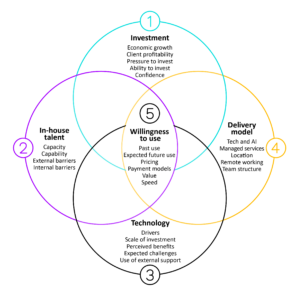Trump 2.0: Impact scenarios for the professional services industry
The new US administration promises significant change that could have ramifications for the global economy. In this blog, we share scenarios of how this is likely to impact the consulting and professional services industry.
Here at Source, we have developed a model which helps anticipate and explain growth in the professional services market. This model has five components to it, each of which has a substantial impact on market size and growth potential. In anticipation of current sociopolitical events (the ambitions of the new US administration included) and recognising major changes going on within firms as well as the markets they serve, we’ve updated and expanded this model.
The five components that drive demand are:
- Investment: Clients buy more external support when they have money to invest and there is external and/or internal pressure to do so.
- In-house talent: Any investment has to be delivered, but all too often client organisations lack the capacity and/or capability to carry out the work involved themselves and so turn to third parties for help.
- Technology: The extent to which clients believe that investment in technology will drive benefits for their organisations has been the stand-out major driver of growth in the last five years.
- Delivery model: Consulting firms have been leading the way in terms of finding new methods to deliver their services, and which clients will want to buy. These include offshoring, technology enablement, and managed services—and other professional services are now following suit.
- Willingness to use: The most reliable predictor of future spend is the extent to which organisations have relied on outside help in the past. However, clients’ expenditure is also influenced by the price they are willing to pay and their perception of the value consulting and professional services firms will deliver.

The policy changes being announced with such speed in the US will impact some of these drivers more than others.
In-house talent: New visa restrictions may make it harder for professional services firms to move their experts around the world and to put entire teams to work alongside clients in other countries, but the fundamental issues are far more deep-seated. Demographic changes mean that clients and firms alike already face serious shortages of key skills. Lack of in-house resources has already boosted client demand since the pandemic, and while consulting firms may want to downplay the extent to which they provide staff augmentation, the reality is that it’s this activity that has kept the consulting industry from contracting in the last two years. Moreover, this is not simply a question of providing armies of junior people: Clients want what we describe as “expert staff augmentation”, which comes at a very different—and elevated—price point.
Technology: Clients’ appetite for technology has changed, initially boosted by the mass shift to hybrid working at the start of the pandemic, it is now being fuelled by a combination of new technology (e.g., AI) and an increasingly desperate desire among clients to find solutions to combat rising costs and poor productivity. By paving the way for a dramatic increase in AI investment, by reducing the barriers to large-scale M&A activity, and by cutting costs (e.g. fuel), the new administration is likely to kick-start a wave of innovation and investment across the US. This will boost demand for technology consulting and implementation in America—but demand is already high everywhere, so this will amplify an existing trend—which is still important but probably won’t create materially different opportunities and challenges.
This leaves us with three areas in which we may see significant change: Investment, delivery model, and clients’ underlying willingness to use third-party support in the future. Even from just these areas, multiple possible scenarios emerge, but we’ve identified three that we think merit consideration.
We’ve called the first one polarisation. In this scenario, the rapid-fire actions we’re already seeing from the new administration benefit some countries and companies more than others. This will substantially exacerbate a trend we’re already seeing, in which clients increasingly fall into one of two camps. They’re either confident enough to make significant investments, or they’re sufficiently alarmed by what may happen that they take immediate action to prepare for the worst. Both of these groups will spend more on consulting and professional services, albeit from very different motives and on very different things. This will create frenetic but unpredictable activity in the consulting and professional services market, putting firms under pressure to invest but without the necessary clarity about what to invest in as clients have so many and such varied needs.
In our paralysis scenario, the opposite is true: all the current sound and fury signifies nothing, as new government initiatives get mired in legal disputes, and different agendas clash. In this environment, most clients are likely to sit in a somewhat uncertain and undecided space, unwilling to make important decisions until they can see which way the economic winds are blowing. Investment levels drop, and so too does spend on external support. Lack of opportunities for consulting and professional services firms will force them—and indeed give them time—to adapt their services to the peaks and troughs of demand and change their delivery models.
Our partnering scenario is driven less by client investment activity and more by how the economic environment will reshape the way clients think about their own organisations and how they can make the best use of their available resources. Irrespective of whether client sentiment is polarised or paralysed, this scenario reflects the pressure clients are under to get things done—whether that’s business as usual or something more innovative—in a very challenging operating environment. Our hypothesis is that this, combined with a growing acceptance of different ways of delivering consulting and professional services (the growth of managed services, for example), will result in clients reconfiguring the boundaries of where their organisation stops, and where third-party roles start. It’s the next step in an evolution that dates back 40 years, during which clients have refined what their core business is or should be. For consulting and professional services firms, success will hinge on the business value they’re seen to create, precisely because they’re stepping beyond their traditional advisory role and will make a much more significant contribution to the way in which their clients—now partners—get things done.
These three scenarios are not exhaustive, of course. But three days into Trump 2.0, we hope it’s food for thought.
Next steps:
If you are interested in understanding more about how Source’s growth model could be applied to your firm and want to gain an objective view on the markets that will matter most to you, then contact us for a bespoke leadership briefing.
And if you enjoyed this blog then do look out for our latest Future of the Firm podcast, in which world-renowned Economist, Michael McMahon, and Source’s CEO, Fiona Czerniawska, delve further into the potential impact of the new US administration on business, consulting, and professional services. Available from 28th January on Spotify, Apple Podcasts, and directly on the Source website.


